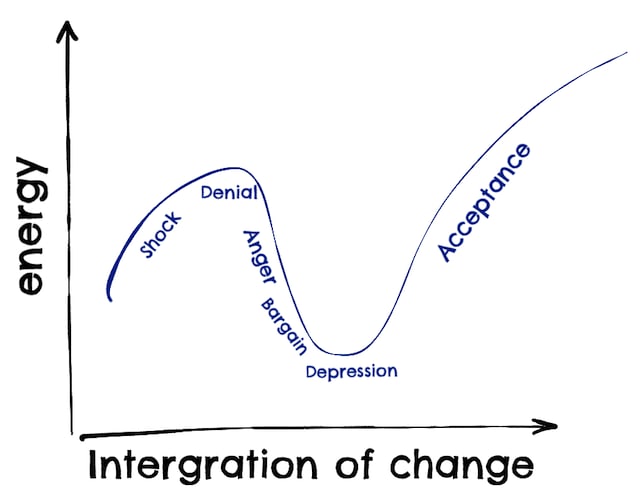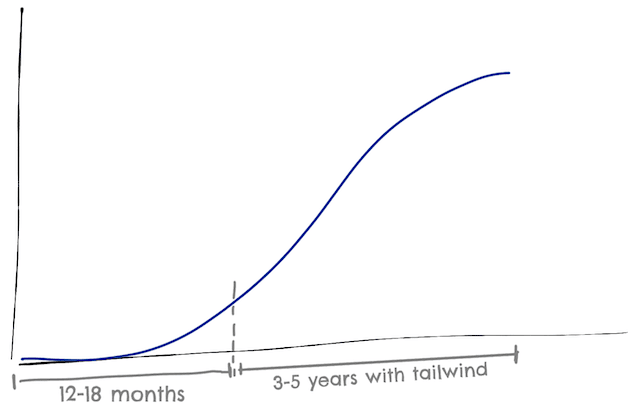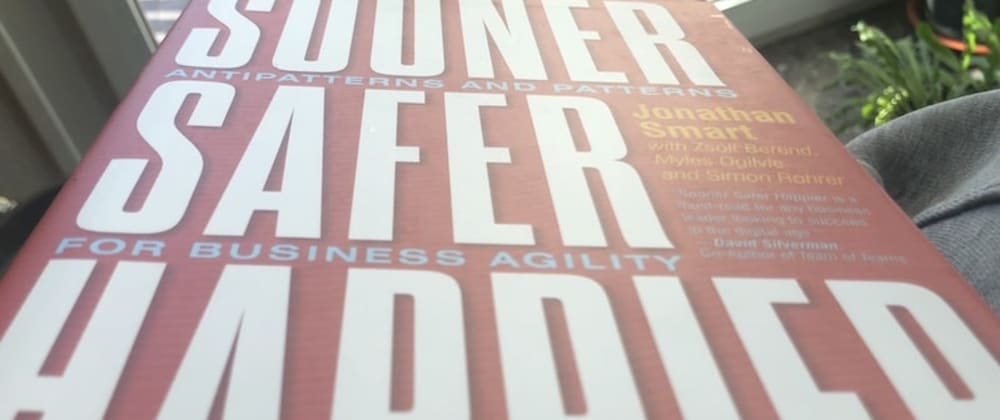These are my notes on Sooner, safer, happier: patterns and anti-patterns for business agility by Jonathan Smart with Zsolt Berend, Myles Ogilvie and Simon Rohrer.
The book is like The DevOps Handbook, but less technical and more org-wide.
Key Insights
- Better Value Sooner Safer Happier (BVSSH):
- Better == quality.
- Value is unique. OKRs.
- Sooner != faster:
- Flow efficiency.
- Lead time.
- Safer: governance, risk, compliance.
- Happier: none of the previous "at any cost".
- "It is not my problem. I did my bit. The hole is on the other side of the boat".
- SW binary is agile-created (complex) and the path to production is lean (complicated).
- Milestones make no sense on emergent (complex) domains.
- Not "the business" but "our business".
- Imposing Agile is not agile.
- Edgar Schein: learning only happens when survival anxiety is greater than learning anxiety (fear of being a noob again).
- "Why" for change must appeal all primary motivators (autonomy, mastery, purpose).
- You cannot over-communicate the why.
- Change is a social activity.
- Invite over Inflict.
- Orgs are complex adaptive systems:
- Any experiment that takes place in them are not experiments because you cannot undo them.
- You are never done improving.
- “We don’t have time. We need to go big.” is a fallacy and self-fulfilling prophecy.
- Cognitive overload: willpower is a limited resource, and when it runs out you fall back on habits.
- As more teams adopt the new ways of working, the impediments will be more systemic and harder to resolve.
- Pattern: Descale Before you Scale.
-
Joseph Campbell: if the path ahead is clear, you are probably on someone else’s.
- Impediments are not in the path; impediments are the path.
- Improvement over time is more important than the absolute value.
- Silence is unhealthy.
- Instead of reporting lines, supporting lines.
- People need to be recognized for the lowest cost and quickest time to failure.
- Water-scrum-fall:
- Urgency paradox: ideas sit 12-18 months on big upfront prioritization, and when they hit the dev team they suddenly become urgent.
- Value streams are not oriented around customer personas.
- Funding is a constraint on which to maximize value.
- Applications and puppies have something in common: they are for life, not just for Christmas.
- Install Jira and Jenkins and you're agile.
- Don't manage dependencies, break team. > Ignorance is the single greatest impediment to throughput. Dan North at Introducing Deliberate Discovery
- Following the plan == not learning. > Humans need to belong to groups, but the tribal instinct is also an instinct to exclude Amy Lynn Chua at Political Tribes
- When a measure becomes a target, it ceases to be a good measure.
- Tacit knowledge can only be shared by socialization (pairing, face-to-face) and a bias for action.
- Learning is more effective when exercises are in the learner context.
- There is no such thing as best practice. Your context is unique.
List of Patterns and Anti-Patterns
| Pattern | Anti-pattern |
|---|---|
| Focus on Outcomes | Doing an Agile Transformation |
| Start with Why; Empower the How | Using Old Ways of Thinking to New Ways of Working |
| Achieve Big Through Small | The Bigger the Capital “T” Transformation, the Bigger the Change Curve |
| Descale Before you Scale | Scaling Agile before Descaling Work |
| Scale Agility, not Agile, Vertically then Sideways | Grass Roots Hits a Grass Ceiling |
| Not one size fits all | One Size Fits All |
| Invite over Inflict | Inflict over Invite |
| Leaders Go First | Do as I say, not as I do |
| Psychological Safety | Psychological unsafe |
| Emergent Mindset with Servant Leadership | Deterministic Mindset |
| Optimize for Fast End-to-End Flow | Local Optimization |
| Outcome Hypothesis | Milestone-driven Predicted solutions |
| Intelligent Flow | Headless Chicken |
| Stop Starting, Start Finishing | Start Starting |
| Safety within Safety | Lack of Safety within Safety |
| Organize Safety by Value Stream | Role-Based Safety Silos |
| Intelligent Control | Fixed Mindset to Risk |
| Go Slower to Go Faster | Going Faster Leads to Going Slower |
| Continuous Technical Excellence | Agile Hollow Shell |
| Architect and Organize for Flow | Misalignment of Teams and Architecture |
| Smart People and Smart Teams with Robot Friends | Tools Over People |
| Optimize for Learning | Information and Learning Silos |
| Nested Learning with Built-in Feedback Loops | Output over Outcomes |
| Communicate, Communicate, Communicate | The Bubble Effect |
| Be Comfortable with Uncertainty | Applying a Deterministic Approach to an Emergent Domain |
| Measure for Learning | Weaponized Metrics |
TOC
- A Sense Of Urgency
- How We Got Here
- Chapter 1 - Focus On Outcomes: Better Value Sooner Safer Happier
- Chapter 2 - Achieve Big Through Small
- Chapter 3 - Optimization over One Way; Invite over Inflict
- Chapter 4 - Leadership Will Make It or Break It
- Chapter 5 - Build the Right Thing; Intelligent Flow
- Chapter 6 - Building the Thing Right; Intelligent Control
- Chapter 7 - Continuous Attention to Technical Excellence
- Chapter 8 - Create a Learning Ecosystem
- Chapter 9 - The Best Time to Plant a Tree is Twenty Years Ago; the Second Best Time is Now
A Sense Of Urgency
- There is no such thing as best practice. Your context is unique.
- Better Value Sooner Safer Happier (BVSSH):
- Better == quality.
- Value is unique.
- Sooner != faster.
- Safer: governance, risk, compliance.
- Happier: none of the previous "at any cost".
- Practices = principles + context.
How We Got Here
- Maximize outcomes with minimal output.
- Doing Agile vs being agile.
- "It is not my problem. I did my bit. The hole is on the other side of the boat".
- SW binary is agile-created (complex) and the path to production is lean (complicated).
Chapter 1 - Focus On Outcomes: Better Value Sooner Safer Happier
- They apply to the whole org:
- Not "the business" but "our business".
- Value == OKRs.
- Sooner:
- Flow efficiency:
- work time / end to end lead time.
- Typically, 10% or lower.
- Lead time:
- Measure the 85% percentile and its change over time.
- Throughput:
- Items per period.
- Should increase when reducing lead time.
- Flow efficiency:
- Values balance each other.
- Cheaper == anti-pattern:
- Increases hidden costs via a reduction in flow efficiency.
- Anti-pattern: Doing an Agile Transformation
- Reasons to try an Agile Transformation:
- “We are being disrupted. If we don’t change we won’t survive”.
- Issues:
- Optimizes for the agile tool, not the outcomes.
- Cargo cult. “Doing agile”.
- Reasons to try an Agile Transformation:
- Anti-pattern: Using Old Ways of Thinking to New Ways of Working.
- Imposing Agile is not agile:
- Top-down, command-and-control.
- Big upfront planning.
- Deadlines.
- Emotional reactions:
- Fear and resistance.
- Loss aversion.
- Agentic state:
- Blindly obey orders, passing the responsibility for the consequences of the person giving the orders.
- Remove intrinsic motivators:
- Autonomy: no choice on Transformation.
- Mastery: new thing, hence becoming a beginner.
- Purpose: If the reason for AT is reducing cost or increasing benefits.
- Imposing Agile is not agile:
- Pattern: Focus on Outcomes.
- Pattern: Start with Why; Empower the How:
- Simon Sinek: people don’t buy what you do, they buy why you do it.
- Edgar Schein: learning only happens when survival anxiety is greater than learning anxiety (fear of being a noob again).
- “Why” for change must appeal all primary motivators.
- You cannot over-communicate the why.
- Orgs are complex adaptive systems:
- Any experiment that takes place in them are not experiments because you cannot undo them.
- Start with:
- Identify early adopters by running a voluntary Community of Practice.
- Create a central Ways of Working Center of Enablement.
- You are never done improving.
Chapter 2 - Achieve Big Through Small
- Anti-pattern: The Bigger the Capital “T” Transformation, the Bigger the Change Curve.
- Change curve:

- “We don’t have time. We need to go big.” is a fallacy and self-fulfilling prophecy.
- Cognitive overload: willpower is a limited resource, and when it runs out you fall back on habits.
- Change curve:
- Anti-pattern: Scaling Agile before Descaling Work.
- Parkinson’s law.
- Also Parkinson: bureaucracies expands at a rate of 5-7% each year irrespective of the variation in the amount of work.
- Policies, standards and controls expand with the number of control staff employed.
- Scale of the org itself can be an impediment for BVSSH.
- Anti-pattern: Grass Roots Hits a Grass Ceiling.
- Pattern: Achieve Big Through Small:
- People have a limited capacity to unlearn and relearn.
- The only way to determine the optimal course of action is by safe-to-learn doing.
- Rule of one:
- 1 experiment.
- 1 customer or team.
- 1 location.
- In production.
- As more teams adopt the new ways of working, the impediments will be more systemic and harder to resolve.
- Don’t continue until these are alleviated.
- Adoption as an S-curve:

- One per business unit and key systemic enabler.
- One small WoW CoE per business unit, reporting to the business unit, not the central CoE.
- Pattern: Descale Before you Scale:
- Descale work and system of work.
- An org is a network of interdependent services:
- Descaling should include breaking dependencies.
- Pattern: Scale Agility, not Agile, Vertically then Sideways.
- New middle management role:
- Ensure that the mission and desired outcomes are clear, then listen, coach and remove impediments.
- Coaching Kata.
- New middle management role:
Chapter 3 - Optimization over One Way; Invite over Inflict
- Anti-pattern: One Size Fits All
- Joseph Campbell: if the path ahead is clear, you are probably on someone else’s.
- Your scaling and cultural context is unique.
- And culture will vary between teams, business units, geography,...
- Anti-pattern: Inflict over Invite.
- Pattern: Not one size fits all:
- Unique VOICE:
-
Values and principles:
- Behavioral guardrails that apply across context.
-
Outcomes and purpose:
- Improvement over time is more important than the absolute value.
- Targets should be avoided as they invite cargo cult and gaming the system.
-
Intent-based leadership:
- High autonomy with high alignment.
-
Coaching and support:
- Coach should be omnists: recognize and respect all bodies of knowledge without fundamentalism.
-
Experimentation:
- Complex system: probe, sense, respond.
- Edgar Schein: you cannot understand a system until you try and change it, and when you do try to change it, only then will the underlying mechanisms maintaining the status quo emerge.
-
Values and principles:
- Unique VOICE:
- “No”, “Not yet” or “What do we stop in order to do this?”
- Impediments are not in the path; impediments are the path.
- Visualize (flow metrics), stabilize (limit WIP), optimize.
- Evolution or revolution (by invitation), depending on your context.
- Only Kanban and Disciplined Agile support evolution.
- Revolution if org is facing an existential crisis, there is support for a bigger dip in the change curve, there is sufficient personal psychological safety, people are volunteering and there is prior experience.
- Pattern: Invite over Inflict:
- Improving BVSSH must be communicated as high priority from the board, and that taking action will lead to recognition.
- Exemplary Community:
- Voluntary.
- Agree to seek to become exemplary.
- Benefits:
- Access to external speakers and experts.
- First to access new tools.
- Keep the innovators on the bleeding edge.
- Members have x20 improvement on most measures.
Chapter 4 - Leadership Will Make It or Break It
- Leader: guiding on a journey, following is optional.
- Commander: control, obey is mandatory.
- Anti-pattern: Do as I say, not as I do:
- Leaders go on the same journey:
- Become a beginner, trying something new, failing.
- Leaders go on the same journey:
- Anti-pattern: Psychological unsafe:
- Boeing as a bad example.
- Cost and schedule should not be the primary focus.
- Leaders’ actions and ability to provide or withhold rewards communicate their preferences, which then become the preoccupation of the workforce.
- Silence is unhealthy.
- Anti-pattern: Deterministic Mindset:
- All non-trivial change and product development is emergent.
- The notion that we can predict what is going to happen is […] wasteful, demoralizing and dangerous.
- Can be caused by leadership being uncomfortable exhibiting vulnerability: not knowing.
- All non-trivial change and product development is emergent.
- Instead of reporting lines, supporting lines.
- Pattern: Leaders Go First:
- Transformational Leadership (vs transactional), from James Burns’ Leadership:
- Role model.
- Vision.
- Intellectual stimulation.
- Coach: care for individuals.
- Transformational Leadership (vs transactional), from James Burns’ Leadership:
- Pattern: Psychological Safety:
- People need to be recognized for the lowest cost and quickest time to failure.
- Steps to build psychological safety:
- Set the stage:
- Not personal incompetence but of the system of work.
- Failure is learning.
- Invite participation.
- Respond productively.
- Set the stage:
- Pattern: Emergent Mindset with Servant Leadership.
Chapter 5 - Build the Right Thing; Intelligent Flow
- Anti pattern: Local Optimization:
- Water-scrum-fall:
- Urgency paradox: ideas sit 12-18 months on big upfront prioritization, and when they hit the dev team they suddenly become urgent.
- Water-scrum-fall:
- Anti-pattern: Milestone-driven Predicted solutions:
- Milestones with RAG status are culturally toxic:
- Red is shame and reprisal.
- Milestones make no sense on emergent domains.
- Milestones with RAG status are culturally toxic:
- Anti-pattern: Headless Chicken.
- Feature factories disconnected from customer needs and company strategy.
- Teams incentivized by output.
- Anti-pattern: Start Starting:
- Reducing WIP increases the chances of identifying causality.
- Pattern: Optimize for Fast End-to-End Flow:
- Identify value-streams:
- Value streams are not oriented around customer personas.
- Map products to value streams. Identify:
- Duplication.
- Monolith that straddles multiple value streams.
- Create small long-lived teams:
- T-shaped, multidisciplinary.
- Roles:
- Value Outcome Lead (VOL):
- The What (value).
- Outward focus.
- Team Outcome Lead (TOL):
- The How for the system of work and people.
- Inward focus.
- Alleviate impediments, build continuous improvement as a daily habit, coach.
- Architecture Outcome Lead (AOL):
- The How of the tech implementation within the org’s broader tech architecture and engineering principles and standards.
- Solutions architect == hands on.
- Enterprise architect provide support and governance across value streams.
- These roles at every level.
- Top level:
- CEO = VOL.
- CIO = TOL.
- CTO = AOL.
- Value Outcome Lead (VOL):
- Funding the Flow of Value:
- Fund by value streams, not by project.
- Funding is a constraint on which to maximize value.
- Identify value-streams:
- Pattern: Outcome Hypothesis:
- Emergence: Toyota Kata.
- Nested outcomes: OKRs.
- Outcome do not cascade, they align.
- Levels:
- Strategic objective (multi year).
- Portfolio objective (<3 years).
- Portfolio epic (<12 months).
- Business outcome (<3 months).
- Experiment (<1 month).
- Business Outcome: > Due to <this insight> > We believe that <this bet> > Will result in <this outcome> > We will know that we are on the right track when: > Measure 1,2,3,...: quantified and measurable leading or lagging indicators.
- Rolling roadmaps and fixed dates:
- Planning is done continuously at the multiple nested cadences.
- From Project Management Office to Value Enablement Teams:
- Coaches and supports measuring business outcomes.
- Assist with prioritization.
- Coaches the limiting of WIP.
- Ensures alignment of nested outcomes.
- Helps collecting lagging and leading data.
- Consolidates data from value streams.
- From “is it done yet?” to “what value we observed, what we have learned, and what steps shall we take next to get closer to the desired outcome?”
- Pattern: Intelligent Flow
- Horizontal nested value streams with the vertical nested outcome hierarchy == high alignment.
- Pattern: Stop Starting, Start Finishing
- Reduce WIP.
- Pull, don't push.
Chapter 6 - Building the Thing Right; Intelligent Control
- Anti-pattern: Lack of Safety within Safety:
- Safety (governance, risk, compliance) people scared of raising concerns due to blame culture.
- Lack of psychological safety in the Safety teams.
- Anti-pattern: Role-Based Safety Silos:
- Each safety specialization (Infosec, Data Privacy, Fraud, ...) being its own silo.
- It causes:
- Duplication.
- Information bubbles.
- Infight between silos and silos vs delivery teams.
- It causes:
- Each safety specialization (Infosec, Data Privacy, Fraud, ...) being its own silo.
- Anti-pattern: Fixed Mindset to Risk:
- Risk management (current/future threads) vs compliance (past issues).
- Pattern: Safety within Safety.
- Pattern: Organize Safety by Value Stream:
- Cross-functional, long-lived safety teams aligned to value streams, with a Centre of Excellence for support, plus a risk catalog.
- Pattern: Intelligent Control:
- Product teams engage with their safety teams on a continuous basis.
- Safety teams reassess on the quarterly business outcome the frequency of engagement, depending on those business outcomes.
- Risk stories validated through automated test, or by Value Outcome Lead, or by Safety team.
Chapter 7 - Continuous Attention to Technical Excellence
- Applications and puppies have something in common: they are for life, not just for Christmas.
- Constant Improvement (Kaizen) and occasional step changes (Kaikaku): Punctuated gradualism.
- Anti-pattern: Going Faster Leads to Going Slower:
- Features, and only features.
- No time to follow good dev practices because:
- Lack of partnership with "Business".
- No time to apply lessons learned.
- System Entropy.
- Anti-pattern: Agile Hollow Shell:
- Agile without technical excellence is Agile work management.
- Anti-pattern: Misalignment of Teams and Architecture.
- Anti-pattern: Tools Over People:
- Install Jira and Jenkins and you're agile.
- Should be: People -> Process -> Tooling.
- No technical career path for hands-on software developers.
- Not having testers: too much automation.
- Pattern: Go Slower to Go Faster:
- Visualize flow of features, defects, risks, debts.
- Prioritize improvement of daily work over daily work.
- Coach for technical excellence/practices is much rarer than "Agile process coach".
- Pattern: Continuous Technical Excellence.
- Pattern: Architect and Organize for Flow.
- Cognitive Load.
- Don't manage dependencies, break team.
- Pattern: Smart People and Smart Teams with Robot Friends:
- Technical career, good example: UK Government digital services career framework.
Chapter 8 - Create a Learning Ecosystem
- Anti-patterns: Information and Learning Silos: > Up to 50% of info is lost on every hand-off. Poppendieck at Implementing Lean SW Dev.
Ignorance is the single greatest impediment to throughput.
Dan North at Introducing Deliberate Discovery
- Anti-pattern: Output over Outcomes:
- Learning whether we have delivered something valuable or not comes from the customer.
-
Anti-pattern: The Bubble Effect:
Humans need to belong to groups, but the tribal instinct is also an instinct to exclude
Amy Lynn Chua at Political Tribes- Silo mentality: not want to share with other tribes.
- Poor learning retention: when people leave, their learnings are lost.
- Duplication.
-
Anti-pattern: Applying a Deterministic Approach to an Emergent Domain:
- Following the plan == not learning.
-
Anti-pattern: Weaponized Metrics:
- When a measure becomes a target, it ceases to be a good measure.
-
Pattern: Optimize for Learning:
- Unlearn.
- Tacit knowledge can only be shared by socialization (pairing, face-to-face) and a bias for action.
- In Clear and Complicated domains: explicit knowledge.
- In Complex and Chaotic: tacit knowledge.
- Identify and break silos with Value Stream Mapping.
-
Pattern: Nested Learning with Built-in Feedback Loops:
- Learning is more effective when exercises are in the learner context.
- Levels:
- Individual:
-
Sharon Bowman four Cs, from Training from the Back of the Room:
- Connections: Learners connect to the topic exploring prior experiences and knowledge.
- Concepts and concrete practices: Self-learn.
- Conclusions: Learners do self-reflection on the learning experience and teach back to the class.
-
Sharon Bowman four Cs, from Training from the Back of the Room:
- Team:
- Stand-ups, weekly reviews, conferences, unconferences, retros, show and tell, pair and mob programming.
- Toyota Improvement Kata.
- Dojos.
- Organization:
- Internal meet-ups, conferences, unconferences, webinars, brown-bag sessions, show-and-tell.
- Individual:
-
Pattern: Communicate, Communicate, Communicate:
- Internal BVSSH Awards:
- Team has to proved factual data and quotes from customers and colleagues.
- Teams will connect with winners for help and advise
- Communities of Practice:
- Voluntary, open to all, Darwinian.
- Meet once every two weeks.
- ASREDS loop: Align, sense, respond, experiment, distill, share.
- Internal BVSSH Awards:
Pattern: Be Comfortable with Uncertainty.
Pattern: Measure for Learning.
Chapter 9 - The Best Time to Plant a Tree is Twenty Years Ago; the Second Best Time is Now
- How to continue from your current starting point and org memory to get better at fast learning in order to optimize for outcomes across the org?:
- Start with Why (why of change, not why agile).
- Focus on outcomes: BVSSH.
- Leaders go first.
- Create a Ways of Working Center of Enablement.
- Start small and create an s-curve of change.
- Invite over Inflict: Start with the natural champions.
- Involve everyone from top to bottom.
- Bias to action: communicate, communicate, communicate:
- Change is a social activity.
- Become a Relearning org:
- You are never done.
- It takes years.







Top comments (0)